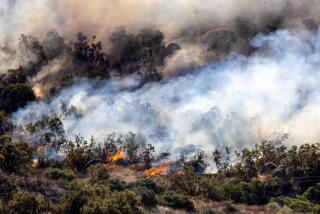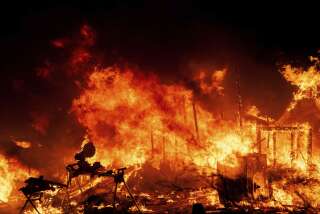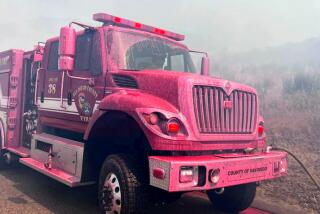New fires threaten homes in Northern California’s El Dorado County, taxing firefighter resources

New brush fires, including one threatening homes in El Dorado County, broke out Wednesday, further straining the efforts of overloaded firefighters who are trying to keep up.
The Omega fire was one of three in burning in the Sierra foothills that sparked evacuations. It had burned more than 30 acres near Pilot Hill, and officials were hitting it with water-dropping aircraft.
The Sunset fire in Placer County was also raging, consuming more than 1,000 acres.
Another fire was burning in northern Mendocino County, about nine miles east of Covelo. The Eel fire, as it is being called, was uncontained after burning 865 acres as of Wednesday morning, according to Cal Fire.
The fire is traveling through quick-burning grass and oak in a rural area of rolling hills that can become steep and difficult to access, Cal Fire Deputy Chief Scott McLean said.
“It’s going to keep growing, hopefully not very much more, but we’ll find out,” McLean said Wednesday morning.
The largest and deadliest of the wildfires burning in California is the Carr fire, which as of Wednesday afternoon had burned 115,538 acres and was 35% contained.
Fire crews have been battling the blaze in triple-digit heat. On Wednesday, however, forecasters said temperatures will return to normal, or close to it, by this weekend. Temperatures will reach the high 90s and humidity will hover around 20%, said Roy Skinner, a spokesman for the California Department of Forestry and Fire Protection.
“Any break in the weather is appreciated — we’re at 35% containment,” he said. “However, we don’t want people to be complacent, or on edge. But the fact is, this fire was started by just one little spark off a vehicle.”
Still, as a low-pressure system approaches from the west, the area could see shifting winds and gusts of up 30 mph, National Weather Service meteorologist Tom Dang said.
“This fire has a very unique personality,” said Jason Shanley, a spokesman for the Carr fire incident response. It’s been active at night, while a stubborn inversion layer has kept smoke low to the ground and hindered air support during the day. Conditions also spawned a fire tornado that ripped through parts of Redding. “Every day there’s a new challenge.”
The fire is now mostly burning on its western flank. On the eastern end, more and more of the 38,000 fire evacuees have been allowed to return to their homes — or what is left of them — in and around Redding.
The Carr fire has claimed six lives so far — those of a Redding fire inspector, a private bulldozer contractor and four civilians. It has also destroyed more than 1,500 structures, becoming the sixth most destructive wildfire in recorded California history.
Gov. Jerry Brown told reporters that large, destructive fires would probably continue and cost the state billions of dollars over the next decade.
“The more serious predictions of warming and fires to occur later in the century, 2040 or 2050, they’re now occurring in real time,” Brown said at a news conference at the state’s emergency operations center outside Sacramento.
State officials said more than 13,000 firefighters are on duty fighting 16 large fires that have burned a total of 320,000 acres and displaced more than 32,000 residents. Seventeen states have offered assistance to California during the last week, sending help from as far away as Maine and Florida. Though the state has the resources now to combat the large wildfires, fighting them and keeping people safe will become harder, Brown said.
“Things will get much tighter in the next five years as the business cycle turns negative and the fires continue,” Brown said.
Myers reported from Sacramento, Cosgrove from Yosemite, and Kohli and Tchekmedyian from Los Angeles.
More to Read
Start your day right
Sign up for Essential California for news, features and recommendations from the L.A. Times and beyond in your inbox six days a week.
You may occasionally receive promotional content from the Los Angeles Times.










